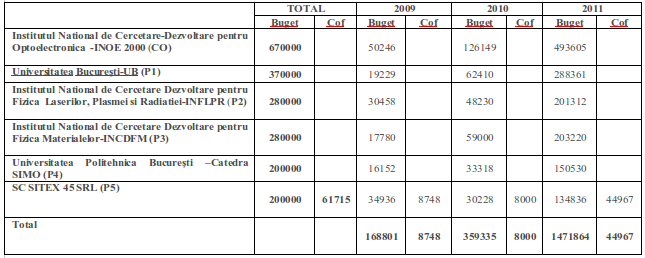Advanced Organometallic Materials for Optoelectronics
- MOMAOPT
The presented project aims to develop new advanced multifunctional organic materials based on lanthanides complexes with luminescent properties that will act as optical amplifiers and waveguides in photonic devices, materials for optical fibres, displays and sensors. The luminescent component is represented by the lanthanides complexes well known for this property. To meet the main objective of this project namely obtaining of new photonic materials targeting the specific sectors of economy, complex researches both theoretical and experimental applicative oriented are needed. The research focuses on enhancing the performances of organic complexes of lanthanides by the following methods:
- complexation of lanthanides in different organic mix matrixes (Schiff bases and azo derivatives) that will ensure: an increased stability by preventing the hydrolysis of complexes (achieved by the higher degree of packing around the lanthanide ion well known for its affinity for water and hydroxyl groups); higher stability in air up to 200 0C (achieved by adjusting the molecular mass of organic complex possible due to the mix organic matrixes); possibility of processing with low production cost as a consequence of increased solubility in usual organic solvents (achieved by possible modifications of functional groups of organic matrixes)
- replacement of C-H bonds in the organic complexes with lowered energy absorptive C-halogen bonds that will increase the fluorescence intensity of lanthanide ions.
- using the electronic structure of different lanthanides cations to enlarge the range of the emitted wavelengths
- encapsulation of the most performing organic complexes with lanthanides in polymeric matrixes with changing the coordination number around the lanthanides cations thus developing new functionalities to the complex system metal-organic-polymer as: increased capacities of optical amplification needed in optical fibres industry; will permit the self organisation in different matrixes (polymer, electrolytes) with increased luminescent properties of the lanthanides-organic complexes.
The project proposes the synthesis of lanthanides-organic complex by diazotising and coupling reactions, encapsulation of these complexes in polymeric matrixes by Matrix Assisted Pulsed Laser Evaporation (MAPLE). Structural characterisation and investigation of the new materials' properties will be achieved by IR, Raman and UV VIS spectroscopy, mass spectrometry, RMN, Atomic Force Microscopy (AFM), X-rays diffraction (RX)X-Ray Photoemission Spectroscopy (XPS), Scanning Electron Microscopy and Energy Dispersive Spectroscopy (SEM-EDX) and Transmission electron microscopy (TEM). There will be also performed investigation referring to the capacity of second harmonic generation, nonlinear optical properties in optic and microwaves domain and specific studies to investigate the possibilities of using organic complexes with Rare Earth (RE) in polymeric matrixes.





